MERCEDES-BENZ G-CLASS SUV 2008 Service Manual
Manufacturer: MERCEDES-BENZ, Model Year: 2008, Model line: G-CLASS SUV, Model: MERCEDES-BENZ G-CLASS SUV 2008Pages: 293, PDF Size: 4.49 MB
Page 41 of 293
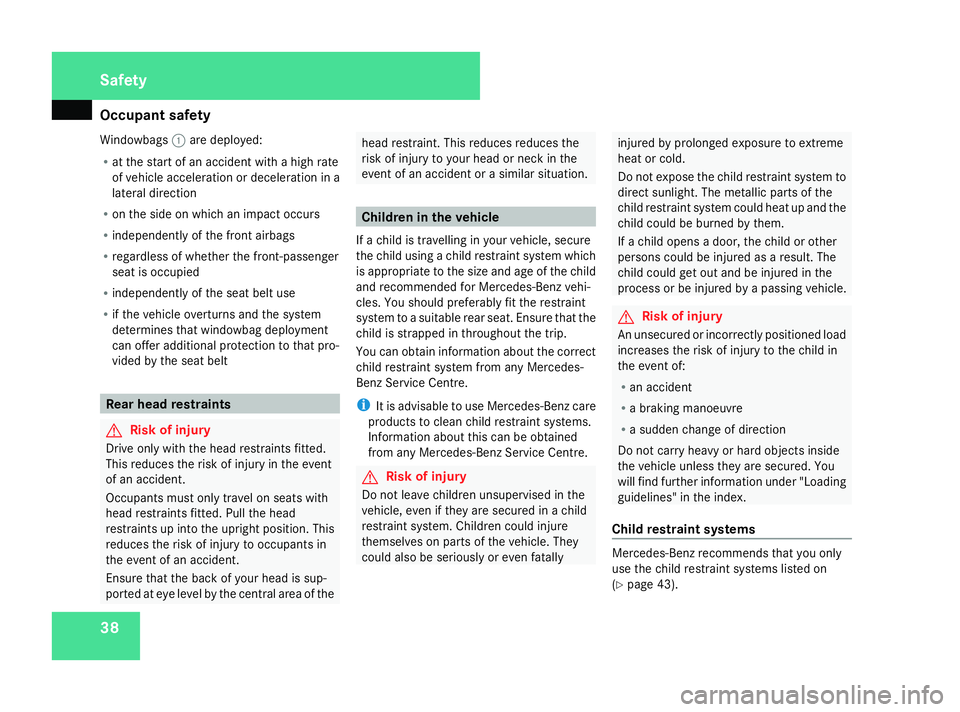
Occupant safety
38
Windowbags
1are deployed:
R at the start of an accident with a high rate
of vehicle acceleration or deceleration in a
lateral direction
R on the side on which an impact occurs
R independently of the front airbags
R regardless of whether the front-passenger
seat is occupied
R independently of the seat belt use
R if the vehicle overturns and the system
determines that windowbag deployment
can offer additional protection to that pro-
vided by the seat belt Rear head restraints
G
Risk of injury
Drive only with the head restraints fitted.
This reduces the risk of injury in the event
of an accident.
Occupants must only travel on seats with
head restraints fitted. Pull the head
restraints up into the upright position. This
reduces the risk of injury to occupants in
the event of an accident.
Ensure that the back of your head is sup-
ported at eye level by the central area of the head restraint. This reduces reduces the
risk of injury to your head or neck in the
event of an accident or a similar situation. Children in the vehicle
If a child is travelling in your vehicle, secure
the child using a child restraint system which
is appropriate to the size and age of the child
and recommended for Mercedes-Benz vehi-
cles. You should preferably fit the restraint
system to a suitable rear seat. Ensure that the
child is strapped in throughout the trip.
You can obtain information about the correct
child restraint system from any Mercedes-
Benz Service Centre.
i It is advisable to use Mercedes-Benz care
products to clean child restraint systems.
Information about this can be obtained
from any Mercedes-Benz Service Centre. G
Risk of injury
Do not leave children unsupervised in the
vehicle, even if they are secured in a child
restraint system. Children could injure
themselves on parts of the vehicle. They
could also be seriously or even fatally injured by prolonged exposure to extreme
heat or cold.
Do not expose the child restraint system to
direct sunlight. The metallic parts of the
child restraint system could heat up and the
child could be burned by them.
If a child opens a door, the child or other
persons could be injured as a result. The
child could get out and be injured in the
process or be injured by a passing vehicle. G
Risk of injury
An unsecured or incorrectly positioned load
increases the risk of injury to the child in
the event of:
R an accident
R a braking manoeuvre
R a sudden change of direction
Do not carry heavy or hard objects inside
the vehicle unless they are secured. You
will find further information under "Loading
guidelines" in the index.
Child restraint systems Mercedes-Benz recommends that you only
use the child restraint systems listed on
(Y
page 43). Safety
463_AKB; 1; 8, en-GB
wobuchh,
Version: 2.10.6 2008-07-17T15:19:41+02:00 - Seite 38Dateiname: 6515_4091_02_buchblock.pdf; preflight
Page 42 of 293
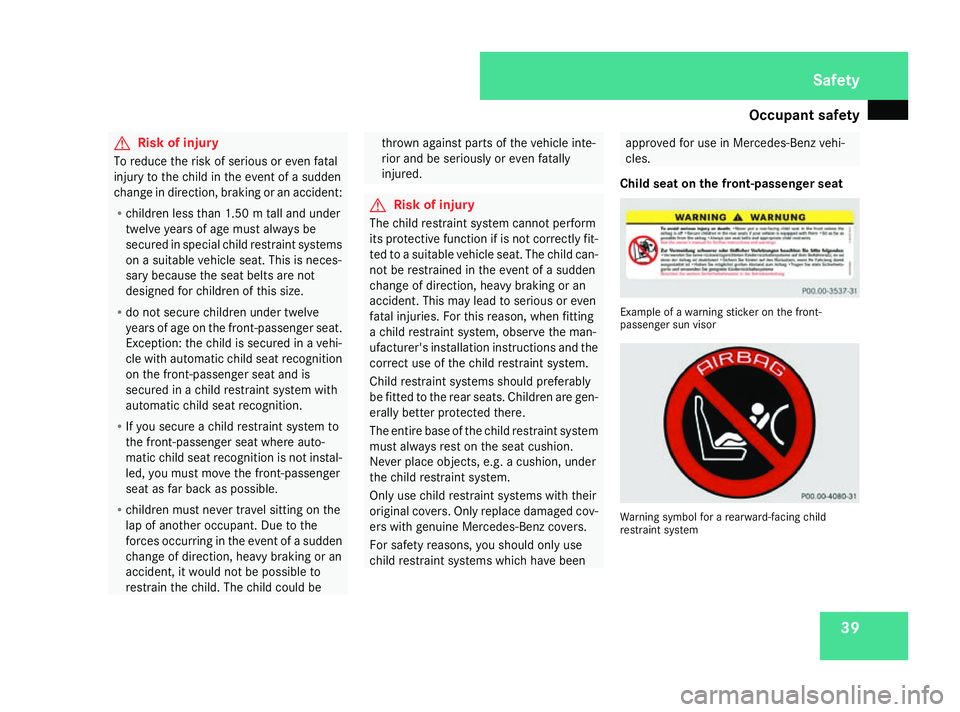
Occupant safety
39G
Risk of injury
To reduce the risk of serious or even fatal
injury to the child in the event of a sudden
change in direction, braking or an accident:
R children less than 1.50 m tall and under
twelve years of age must always be
secured in special child restraint systems
on a suitable vehicle seat. This is neces-
sary because the seat belts are not
designed for children of this size.
R do not secure children under twelve
years of age on the front-passenger seat.
Exception: the child is secured in a vehi-
cle with automatic child seat recognition
on the front-passenger seat and is
secured in a child restraint system with
automatic child seat recognition.
R If you secure a child restraint system to
the front-passenger seat where auto-
matic child seat recognition is not instal-
led, you must move the front-passenger
seat as far back as possible.
R children must never travel sitting on the
lap of another occupant. Due to the
forces occurring in the event of a sudden
change of direction, heavy braking or an
accident, it would not be possible to
restrain the child. The child could be thrown against parts of the vehicle inte-
rior and be seriously or even fatally
injured.
G
Risk of injury
The child restraint system cannot perform
its protective function if is not correctly fit-
ted to a suitable vehicle seat. The child can-
not be restrained in the event of a sudden
change of direction, heavy braking or an
accident. This may lead to serious or even
fatal injuries. For this reason, when fitting
a child restraint system, observe the man-
ufacturer's installation instructions and the
correct use of the child restraint system.
Child restraint systems should preferably
be fitted to the rear seats. Children are gen-
erally better protected there.
The entire base of the child restraint system
must always rest on the seat cushion.
Never place objects, e.g. a cushion, under
the child restraint system.
Only use child restraint systems with their
original covers. Only replace damaged cov-
ers with genuine Mercedes-Benz covers.
For safety reasons, you should only use
child restraint systems which have been approved for use in Mercedes-Benz vehi-
cles.
Child seat on the front-passenger seat Example of a warning sticker on the front-
passenger sun visor
Warning symbol for a rearward-facing child
restraint system Safety
463_AKB; 1; 8, en-GB
wobuchh,
Version: 2.10.6
2008-07-17T15:19:41+02:00 - Seite 39 ZDateiname: 6515_4091_02_buchblock.pdf; preflight
Page 43 of 293
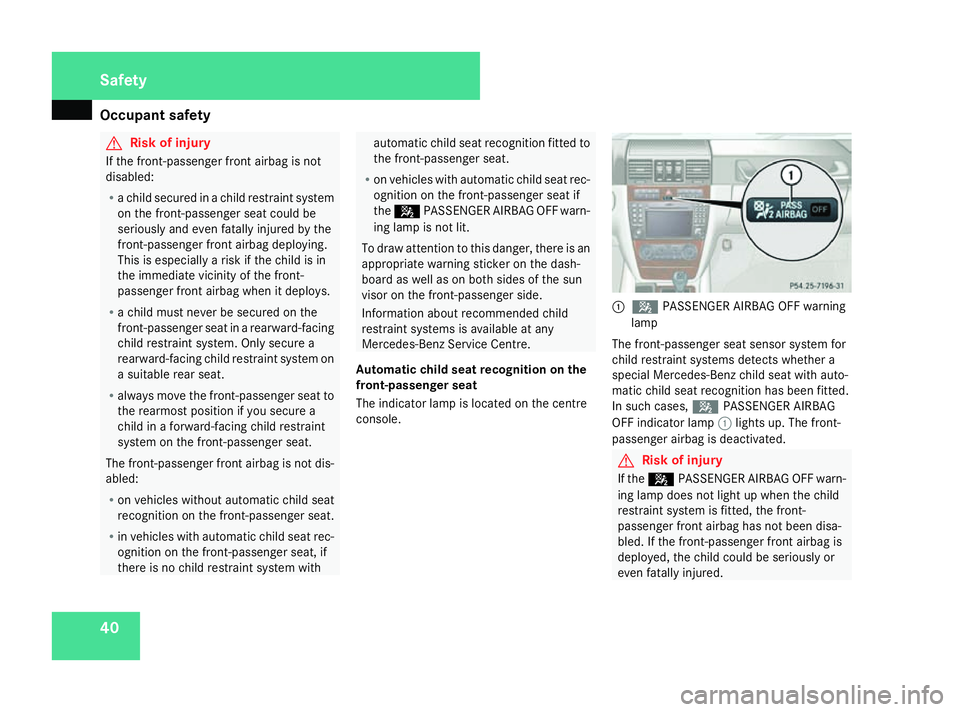
Occupant safety
40 G
Risk of injury
If the front-passenger front airbag is not
disabled:
R a child secured in a child restraint system
on the front-passenger seat could be
seriously and even fatally injured by the
front-passenger front airbag deploying.
This is especially a risk if the child is in
the immediate vicinity of the front-
passenger front airbag when it deploys.
R a child must never be secured on the
front-passenger seat in a rearward-facing
child restraint system. Only secure a
rearward-facing child restraint system on
a suitable rear seat.
R always move the front-passenger seat to
the rearmost position if you secure a
child in a forward-facing child restraint
system on the front-passenger seat.
The front-passenger front airbag is not dis-
abled:
R on vehicles without automatic child seat
recognition on the front-passenger seat.
R in vehicles with automatic child seat rec-
ognition on the front-passenger seat, if
there is no child restraint system with automatic child seat recognition fitted to
the front-passenger seat.
R on vehicles with automatic child seat rec-
ognition on the front-passenger seat if
the 5 PASSENGER AIRBAG OFF warn-
ing lamp is not lit.
To draw attention to this danger, there is an
appropriate warning sticker on the dash-
board as well as on both sides of the sun
visor on the front-passenger side.
Information about recommended child
restraint systems is available at any
Mercedes-Benz Service Centre.
Automatic child seat recognition on the
front-passenger seat
The indicator lamp is located on the centre
console. 1
5 PASSENGER AIRBAG OFF warning
lamp
The front-passenger seat sensor system for
child restraint systems detects whether a
special Mercedes-Benz child seat with auto-
matic child seat recognition has been fitted.
In such cases, 5PASSENGER AIRBAG
OFF indicator lamp 1lights up. The front-
passenger airbag is deactivated. G
Risk of injury
If the 5 PASSENGER AIRBAG OFF warn-
ing lamp does not light up when the child
restraint system is fitted, the front-
passenger front airbag has not been disa-
bled. If the front-passenger front airbag is
deployed, the child could be seriously or
even fatally injured. Safety
463_AKB; 1; 8, en-GB
wobuchh,
Version: 2.10.6 2008-07-17T15:19:41+02:00 - Seite 40Dateiname: 6515_4091_02_buchblock.pdf; preflight
Page 44 of 293
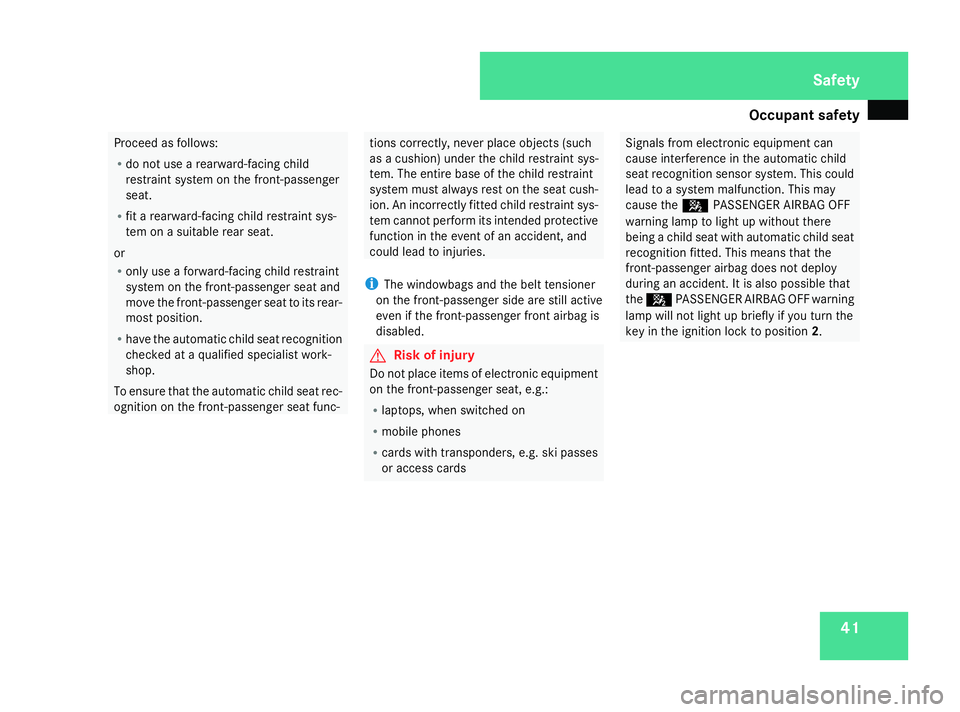
Occupant safety
41Proceed as follows:
R
do not use a rearward-facing child
restraint system on the front-passenger
seat.
R fit a rearward-facing child restraint sys-
tem on a suitable rear seat.
or
R only use a forward-facing child restraint
system on the front-passenger seat and
move the front-passenger seat to its rear-
most position.
R have the automatic child seat recognition
checked at a qualified specialist work-
shop.
To ensure that the automatic child seat rec-
ognition on the front-passenger seat func- tions correctly, never place objects (such
as a cushion) under the child restraint sys-
tem. The entire base of the child restraint
system must always rest on the seat cush-
ion. An incorrectly fitted child restraint sys-
tem cannot perform its intended protective
function in the event of an accident, and
could lead to injuries.
i The windowbags and the belt tensioner
on the front-passenger side are still active
even if the front-passenger front airbag is
disabled. G
Risk of injury
Do not place items of electronic equipment
on the front-passenger seat, e.g.:
R laptops, when switched on
R mobile phones
R cards with transponders, e.g. ski passes
or access cards Signals from electronic equipment can
cause interference in the automatic child
seat recognition sensor system. This could
lead to a system malfunction. This may
cause the
5PASSENGER AIRBAG OFF
warning lamp to light up without there
being a child seat with automatic child seat
recognition fitted. This means that the
front-passenger airbag does not deploy
during an accident. It is also possible that
the 5 PASSENGER AIRBAG OFF warning
lamp will not light up briefly if you turn the
key in the ignition lock to position 2. Safety
463_AKB; 1; 8, en-GB
wobuchh,
Version: 2.10.6 2008-07-17T15:19:41+02:00 - Seite 41 ZDateiname: 6515_4091_02_buchblock.pdf; preflight
Page 45 of 293
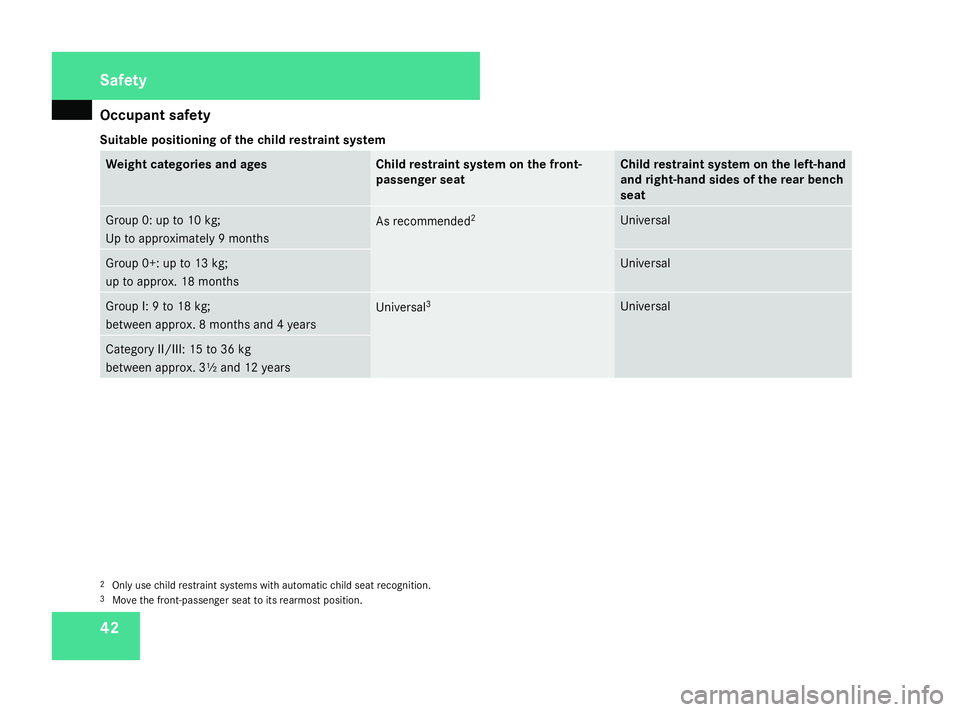
Occupant safety
42
Suitable positioning of the child restraint system Weight categories and ages Child restraint system on the front-
passenger seat Child restraint system on the left-hand
and right-hand sides of the rear bench
seat
Group 0: up to 10 kg;
Up to approximately 9 months
As recommended
2 Universal
Group 0+: up to 13 kg;
up to approx. 18 months Universal
Group I: 9 to 18 kg;
between approx. 8 months and 4 years Universal
3 Universal
Category II/III: 15 to 36 kg
between approx. 3½ and 12 years
2
Only use child restraint systems with automatic child seat recognition.
3 Move the front-passenger seat to its rearmost position. Safety
463_AKB; 1; 8, en-GB
wobuchh,
Version: 2.10.6 2008-07-17T15:19:41+02:00 - Seite 42Dateiname: 6515_4091_02_buchblock.pdf; preflight
Page 46 of 293
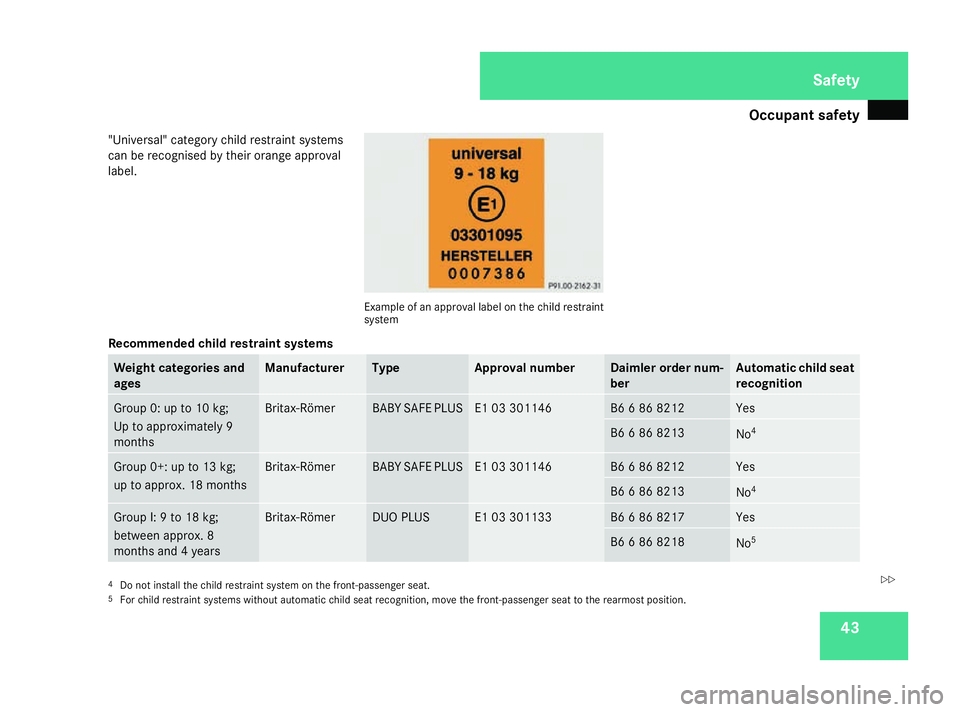
Occupant safety
43
"Universal" category child restraint systems
can be recognised by their orange approval
label. Example of an approval label on the child restraint
system
Recommended child restraint systems Weight categories and
ages Manufacturer Type Approval number Daimler order num-
ber Automatic child seat
recognition
Group 0: up to 10 kg;
Up to approximately 9
months Britax-Römer BABY SAFE PLUS E1 03 301146 B6 6 86 8212 Yes
B6 6 86 8213
No
4 Group 0+: up to 13 kg;
up to approx. 18 months Britax-Römer BABY SAFE PLUS E1 03 301146 B6 6 86 8212 Yes
B6 6 86 8213
No
4 Group I: 9 to 18 kg;
between approx. 8
months and 4 years Britax-Römer DUO PLUS E1 03 301133 B6 6 86 8217 Yes
B6 6 86 8218
No
5 4
Do not install the child restraint system on the front-passenger seat.
5 For child restraint systems without automatic child seat recognition, move the front-passenger seat to the rearmost position. Safety
463_AKB; 1; 8, en-GB
wobuchh, Version: 2.10.6 2008-07-17T15:19:41+02:00 - Seite 43 ZDateiname: 6515_4091_02_buchblock.pdf; preflight
Page 47 of 293
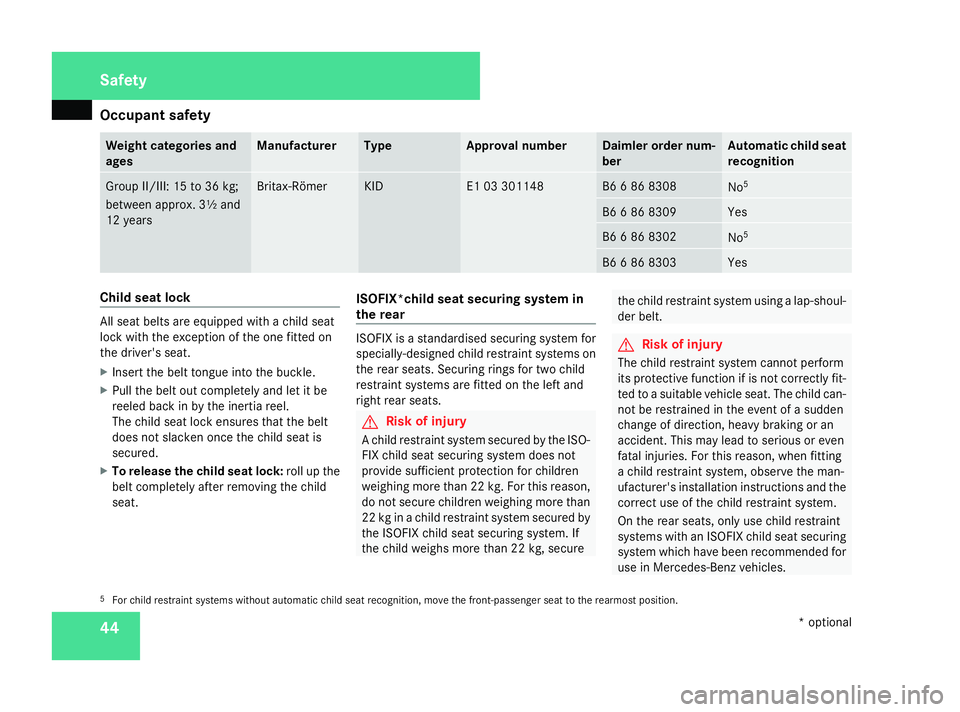
Occupant safety
44 Weight categories and
ages Manufacturer Type Approval number Daimler order num-
ber Automatic child seat
recognition
Group II/III: 15 to 36 kg;
between approx. 3½ and
12 years Britax-Römer KID E1 03 301148 B6 6 86 8308
No
5 B6 6 86 8309 Yes
B6 6 86 8302
No
5 B6 6 86 8303 Yes
Child seat lock
All seat belts are equipped with a child seat
lock with the exception of the one fitted on
the driver's seat.
X Insert the belt tongue into the buckle.
X Pull the belt out completely and let it be
reeled back in by the inertia reel.
The child seat lock ensures that the belt
does not slacken once the child seat is
secured.
X To release the child seat lock: roll up the
belt completely after removing the child
seat. ISOFIX*child seat securing system in
the rear ISOFIX is a standardised securing system for
specially-designed child restraint systems on
the rear seats. Securing rings for two child
restraint systems are fitted on the left and
right rear seats. G
Risk of injury
A child restraint system secured by the ISO-
FIX child seat securing system does not
provide sufficient protection for children
weighing more than 22 kg. For this reason,
do not secure children weighing more than
22 kg in a child restraint system secured by
the ISOFIX child seat securing system. If
the child weighs more than 22 kg, secure the child restraint system using a lap-shoul-
der belt.
G
Risk of injury
The child restraint system cannot perform
its protective function if is not correctly fit-
ted to a suitable vehicle seat. The child can-
not be restrained in the event of a sudden
change of direction, heavy braking or an
accident. This may lead to serious or even
fatal injuries. For this reason, when fitting
a child restraint system, observe the man-
ufacturer's installation instructions and the
correct use of the child restraint system.
On the rear seats, only use child restraint
systems with an ISOFIX child seat securing
system which have been recommended for
use in Mercedes-Benz vehicles.
5 For child restraint systems without automatic child seat recognition, move the front-passenger seat to the rearmost position. Safety
* optional
463_AKB; 1; 8, en-GB
wobuchh,
Version: 2.10.6 2008-07-17T15:19:41+02:00 - Seite 44Dateiname: 6515_4091_02_buchblock.pdf; preflight
Page 48 of 293
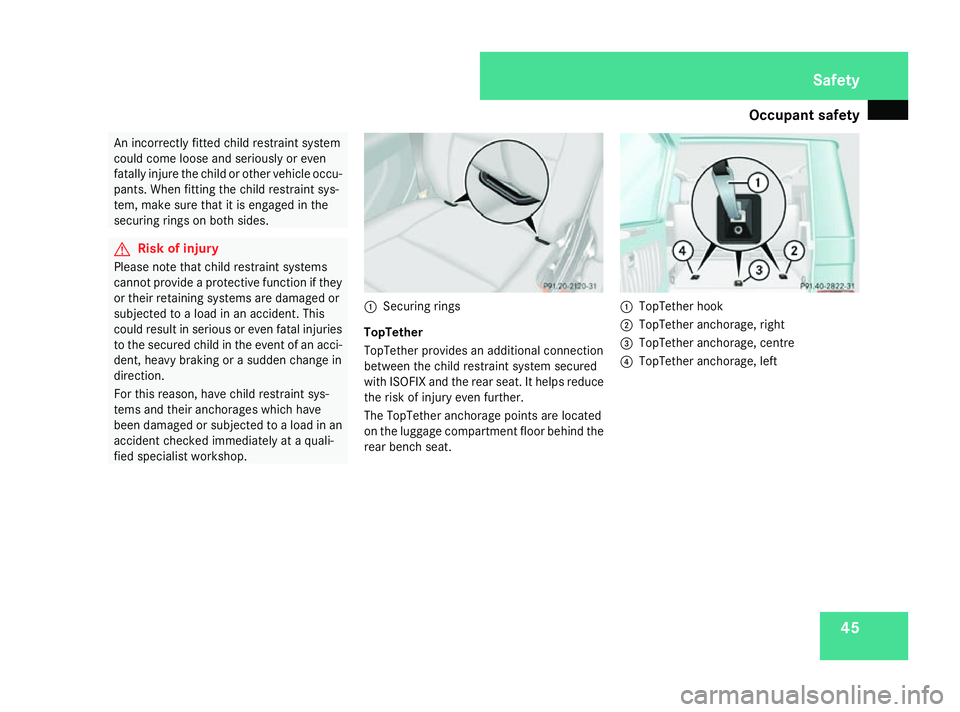
Occupant safety
45An incorrectly fitted child restraint system
could come loose and seriously or even
fatally injure the child or other vehicle occu-
pants. When fitting the child restraint sys-
tem, make sure that it is engaged in the
securing rings on both sides. G
Risk of injury
Please note that child restraint systems
cannot provide a protective function if they
or their retaining systems are damaged or
subjected to a load in an accident. This
could result in serious or even fatal injuries
to the secured child in the event of an acci-
dent, heavy braking or a sudden change in
direction.
For this reason, have child restraint sys-
tems and their anchorages which have
been damaged or subjected to a load in an
accident checked immediately at a quali-
fied specialist workshop. 1
Securing rings
TopTether
TopTether provides an additional connection
between the child restraint system secured
with ISOFIX and the rear seat. It helps reduce
the risk of injury even further.
The TopTether anchorage points are located
on the luggage compartment floor behind the
rear bench seat. 1
TopTether hook
2 TopTether anchorage, right
3 TopTether anchorage, centre
4 TopTether anchorage, left Safety
463_AKB; 1; 8, en-GB
wobuchh, Version: 2.10.6 2008-07-17T15:19:41+02:00 - Seite 45 ZDateiname: 6515_4091_02_buchblock.pdf; preflight
Page 49 of 293
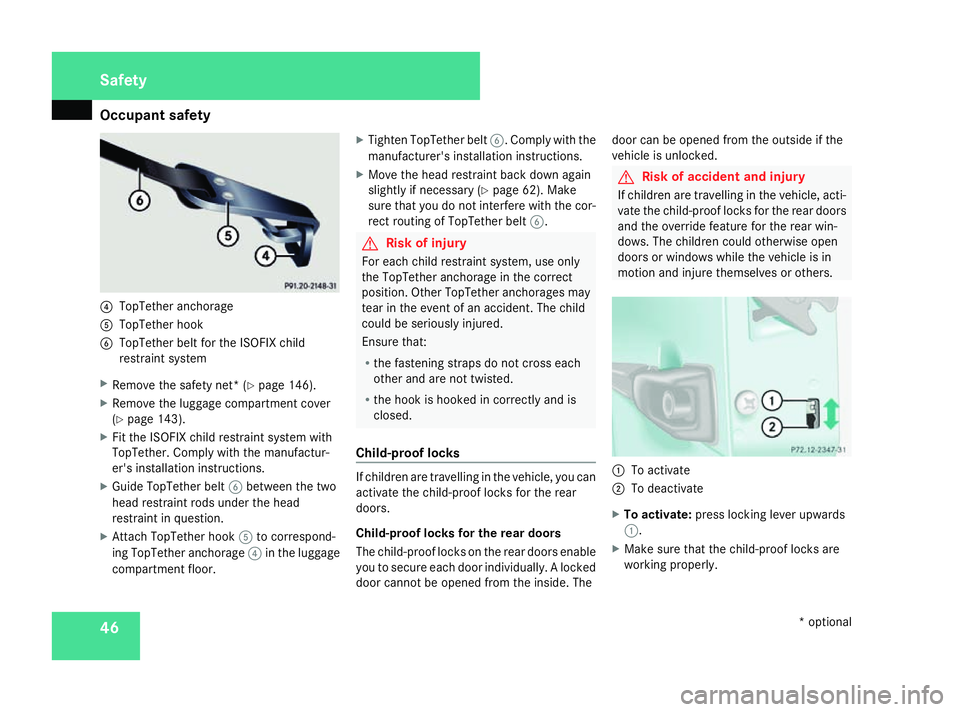
Occupant safety
464
TopTether anchorage
5 TopTether hook
6 TopTether belt for the ISOFIX child
restraint system
X Remove the safety net* (Y page 146).
X Remove the luggage compartment cover
(Y page 143).
X Fit the ISOFIX child restraint system with
TopTether. Comply with the manufactur-
er's installation instructions.
X Guide TopTether belt 6between the two
head restraint rods under the head
restraint in question.
X Attach TopTether hook 5to correspond-
ing TopTether anchorage 4in the luggage
compartment floor. X
Tighten TopTether belt 6. Comply with the
manufacturer's installation instructions.
X Move the head restraint back down again
slightly if necessary (Y page 62). Make
sure that you do not interfere with the cor-
rect routing of TopTether belt 6. G
Risk of injury
For each child restraint system, use only
the TopTether anchorage in the correct
position. Other TopTether anchorages may
tear in the event of an accident. The child
could be seriously injured.
Ensure that:
R the fastening straps do not cross each
other and are not twisted.
R the hook is hooked in correctly and is
closed.
Child-proof locks If children are travelling in the vehicle, you can
activate the child-proof locks for the rear
doors.
Child-proof locks for the rear doors
The child-proof locks on the rear doors enable
you to secure each door individually. A locked
door cannot be opened from the inside. Thedoor can be opened from the outside if the
vehicle is unlocked. G
Risk of accident and injury
If children are travelling in the vehicle, acti-
vate the child-proof locks for the rear doors
and the override feature for the rear win-
dows. The children could otherwise open
doors or windows while the vehicle is in
motion and injure themselves or others. 1
To activate
2 To deactivate
X To activate: press locking lever upwards
1.
X Make sure that the child-proof locks are
working properly. Safety
* optional
463_AKB; 1; 8, en-GB
wobuchh,
Version: 2.10.6
2008-07-17T15:19:41+02:00 - Seite 46 Dateiname: 6515_4091_02_buchblock.pdf; preflight
Page 50 of 293
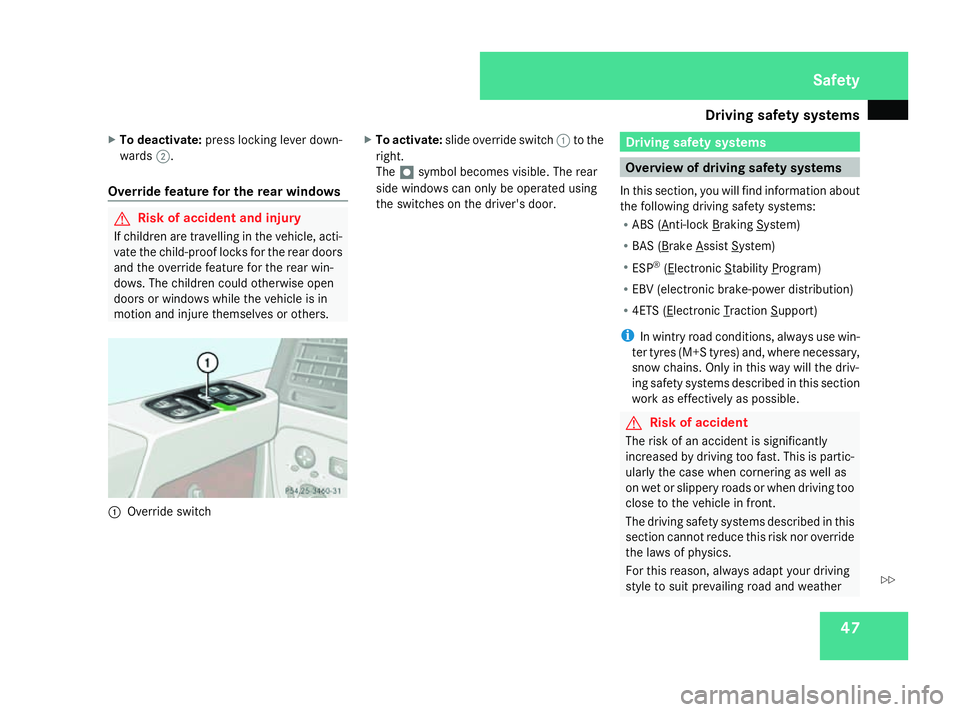
Driving safety sys
tems 47
X
To deactivate: press locking lever down-
wards 2.
Override feature for the rear windows G
Risk of accident and injury
If children are travelling in the vehicle, acti-
vate the child-proof locks for the rear doors
and the override feature for the rear win-
dows. The children could otherwise open
doors or windows while the vehicle is in
motion and injure themselves or others. 1
Override switch X
To activate: slide override switch 1to the
right.
The 7symbol becomes visible. The rear
side windows can only be operated using
the switches on the driver's door. Driving safety systems
Overview of driving safety systems
In this section, you will find information about
the following driving safety systems:
R ABS ( Anti-lock Braking System)
R BAS ( Brake Assist System)
R ESP ®
( Electronic Stability Program)
R EBV (electronic brake-power distribution)
R 4ETS ( Electronic Traction Support)
i In wintry road conditions, always use win-
ter tyres (M+S tyres) and, where necessary,
snow chains. Only in this way will the driv-
ing safety systems described in this section
work as effectively as possible. G
Risk of accident
The risk of an accident is significantly
increased by driving too fast. This is partic-
ularly the case when cornering as well as
on wet or slippery roads or when driving too
close to the vehicle in front.
The driving safety systems described in this
section cannot reduce this risk nor override
the laws of physics.
For this reason, always adapt your driving
style to suit prevailing road and weather Safety
463_AKB; 1; 8, en-GB
wobuchh
,V ersion: 2.10.6
2008-07-17T15:19:41+02:00 - Seite 47 ZDateiname: 6515_4091_02_buchblock.pdf; preflight